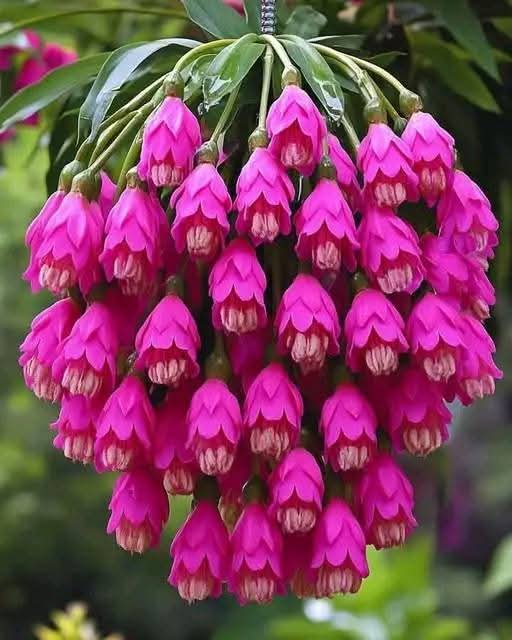Nature never ceases to amaze us with its stunning floral displays, and one of the most breathtaking sights is the Hanging Pink Bell Flower. With its vibrant pink blooms cascading down in elegant clusters, this plant creates a spectacular visual impact in gardens, hanging baskets, and landscapes.
Whether you’re a gardening enthusiast or simply someone who appreciates nature’s artistry, this article will guide you through the care, propagation, and benefits of growing the Hanging Pink Bell Flower in your garden.
🌺 What Makes the Hanging Pink Bell Flower Special?
This stunning plant stands out for several reasons:
✅ Exquisite Floral Display – Its bell-shaped, deep-pink blooms hang in dense, graceful clusters, making it a showstopper.
✅ Ideal for Vertical Gardening – Perfect for hanging baskets, trellises, and pergolas, creating a cascading floral curtain.
✅ Attracts Pollinators – Bees, butterflies, and hummingbirds flock to its nectar-rich flowers, supporting biodiversity.
✅ Easy to Grow – Requires minimal maintenance, making it a great choice for both beginner and expert gardeners.
Now, let’s explore how to care for, grow, and maintain this beautiful plant.
🪴 How to Grow & Care for Hanging Pink Bell Flowers
These flowers thrive in specific conditions, but with the right care, they will reward you with abundant blooms.
- Light Requirements ☀️
The Hanging Pink Bell Flower loves bright, indirect light but can also tolerate partial shade.
🌿 Best Lighting Conditions:
Full sun (morning and late afternoon light) is ideal for maximum flowering.
Partial shade is recommended in regions with intense summer heat to prevent leaf scorch.
Indoors, place near a south- or east-facing window for best growth.
- Watering Needs 💦
Proper watering is crucial for healthy growth and continuous flowering.
🌱 How to Water Properly:
Keep the soil evenly moist but not soggy.
Water deeply once or twice a week, allowing the soil to dry slightly between waterings.
Reduce watering during winter dormancy to prevent root rot.
Use room-temperature water to avoid shocking the plant.
- Ideal Temperature & Humidity 🌡️
These flowers thrive in warm, moderate climates but can adapt to various conditions.
🌡️ Temperature Ranges:
Optimal growth: 60-80°F (15-27°C).
Protect from frost – if temperatures drop below 50°F (10°C), move the plant indoors.
💦 Humidity Needs:
Prefers moderate to high humidity (50-70%).
If the air is dry, mist the plant occasionally or use a humidity tray.
- Best Soil Type 🌱
Well-draining, nutrient-rich soil is essential for healthy root development.
✅ Best Soil Mix:
A blend of loamy soil, compost, and perlite ensures good aeration and drainage.
Avoid clay-heavy soils, which can retain too much water and lead to root rot.
A slightly acidic to neutral pH (6.0-7.0) is ideal.
- Fertilizing for Abundant Blooms 🌿
Regular feeding enhances flower production and overall plant health.
🧪 Fertilizing Schedule:
Spring to summer: Apply a balanced liquid fertilizer (10-10-10 or 20-20-20) every 2-4 weeks.
Bloom booster: Use a fertilizer high in phosphorus (e.g., 5-10-5) to encourage flowering.
Fall and winter: Reduce feeding when the plant enters dormancy.
- Pruning & Maintenance ✂️
Regular pruning helps maintain the plant’s shape and encourages new flower growth.
🌱 How to Prune Effectively:
Trim back spent flowers and leggy stems to promote new buds.
Cut away dead or yellowing leaves to maintain plant health.
Shape the plant after flowering season for a fuller, bushier appearance.
🌱 How to Propagate Hanging Pink Bell Flowers
One of the best aspects of this plant is how easily it propagates, allowing you to grow more flowers or share them with friends.
Step-by-Step Guide:
1️⃣ Stem Cuttings:
Take a 6-inch cutting from a healthy stem.
Remove the bottom leaves and let the cutting dry for a few hours.
Plant in moist soil and keep in indirect light until roots form.
2️⃣ Seeds:
Sow seeds in light, well-draining soil.
Keep the soil moist and warm (70°F/21°C) for germination.
Transplant seedlings once they develop strong roots and leaves.
🌿 Common Problems & Solutions
Even the healthiest plants can encounter issues. Here’s how to troubleshoot common problems:
🟡 Yellow Leaves
✅ Cause: Overwatering or poor drainage.
✔️ Fix: Reduce watering and improve soil aeration.
🛑 No Blooms
✅ Cause: Not enough sunlight or nutrients.
✔️ Fix: Move to a brighter spot and fertilize with a phosphorus-rich formula.
⚫ Wilting or Drooping
✅ Cause: Underwatering or root rot.
✔️ Fix: Water thoroughly but ensure proper drainage.
🎨 Landscaping & Decorative Uses
The Hanging Pink Bell Flower is incredibly versatile and can be used in various ways to enhance your garden.
🏡 Creative Ways to Display:
✅ Hanging Baskets – Perfect for balconies, patios, and indoor spaces.
✅ Trellises & Arches – Adds a romantic, cascading effect to garden entrances.
✅ Pergolas & Gazebos – Creates a stunning floral canopy.
✅ Container Gardens – Mix with other colorful flowers for a vibrant display.
🌟 Why You Should Grow the Hanging Pink Bell Flower
Still wondering if this plant is right for you? Here are some great reasons to add it to your garden:
✅ Low Maintenance – Requires minimal care but delivers stunning results.
✅ Pollinator-Friendly – Attracts bees, butterflies, and hummingbirds.
✅ Year-Round Appeal – Gorgeous foliage even when not in bloom.
✅ Perfect for Small Spaces – Ideal for apartments, balconies, and patios.
🎉 Final Thoughts: Bring This Floral Beauty to Your Home!
The Hanging Pink Bell Flower is a true masterpiece of nature, combining elegance, vibrant colors, and easy care into one stunning plant. Whether you want to decorate your garden, attract pollinators, or add a splash of color to your home, this flower is a must-have!
🌸 Do you have a Hanging Pink Bell Flower in your garden? Share your experiences in the comments below! 🌿✨
